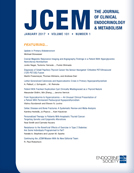-
Views
-
Cite
Cite
LUCA CHIOVATO, PAOLO VITTI, ANTONIO LOMBARDI, LEONARD D. KOHN, ALDO PINCHERA, Expression of the Microsomal Antigen on the Surface of Continuously Cultured Rat Thyroid Cells Is Modulated by Thyrotropin, The Journal of Clinical Endocrinology & Metabolism, Volume 61, Issue 1, 1 July 1985, Pages 12–16, https://doi.org/10.1210/jcem-61-1-12
Close - Share Icon Share
Abstract
The thyroid microsomal antigen, commonly implicated in thyroid autoimmune diseases, is not confined to cytoplasm, but is also present on the surface of human thyroid cells in primary culture. In this study, a strain of differentiated rat thyroid cells (FRTL5) grown in continuous culture was used to investigate the relationship between functional status of the thyroid cell and expression of microsomal antigen on its surface. Sera from eight patients with Hashimoto's thyroiditis, one with idiopathic hypothyroidism, and three with hyperthyroid Graves' disease were selected for the presence of microsomal antibody, but undetectable thyroglobulin antibody. One additional serum sample from a patient with Graves' disease, which was negative for both thyroid antibodies was used. Sera from eight normal subjects were used as controls. Indirect immunofluorescence was applied to FRTLS cells that were viable or fixed with acetone in order to expose intracellular antigens. When FRTL5 cells were cultured in Coon's medium containing TSH (300 μU/ml), positive indirect immunofluorescence surface staining was observed with sera containing microsomal antibody, but not with control sera or with the Graves' serum negative for microsomal antibody. A rough correlation was found between the intensity of the surface fluorescence and microsomal antibody titer. After acetone treatment, microsomal. antibody-positive sera produced typical cytoplasmic staining. When FRTL5 cells were cultured in the absence of TSH, disappearance of the surface fluorescence and reduction of the cytoplasmic microsomal antigen occurred. Readdition of TSH progressively restored both the surface and cytoplasmic microsomal antigen. The present data indicate that the thyroid microsomal antigen is represented on the surface of FRTL5 cells, and its expression is modulated by TSH.





